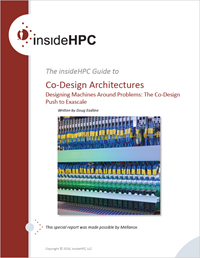
High Performance Computing (HPC) has always been about pushing the limits of technology. The evolution of HPC systems can be broken into three distinct epochs defined by the economics and technology of the day. Initially, specialized supercomputers were built that excelled at mathematical operations (FLOPS). As fabrication costs escalated, clusters of low cost servers connected with high speed interconnects (e.g. InfiniBand) replaced these monolithic multiprocessor systems. The next epoch is defined by the multi/many-core revolution where physical limitations required chip designs to expand the number of processing cores instead of increasing processor frequency. The final and most recent epoch, is that of co design architecture where HPC systems are purpose built using input from application users and software developers.
Network co-design includes offloading network responsibilities from the host processor to the network card. Non-offload designs, that use the processor for all the heavy lifting (onloading), have relied on the increase in processor speed and the growth of multicore systems to keep data moving at top speeds. However, research has shown that the reliance on clock speed can severely degrade network performance when slower processors are used. In particular, the power budget required to put more cores in a single processor has actually forced a lowering of clock speed. Benchmarks for real applications have shown an advantage for offload (vs. onload) HPC networks.
The recent supercomputing refresh in the United States was announced as part of the Collaboration of Oak Ridge, Argonne, and Lawrence Livermore Labs (CORAL) procurement. Co-design architecture is an integral part of these systems and is expected to contribute to their enhanced performance when they become operational in the 2017/2018 time frame. Finally, co-design is not limited to HPC systems. Big data analytics use general-purpose tools (e.g Hadoop, Spark) and when systems are optimized for a specific problem, large performance gains are realized.
The use of co design architecture and offloading are important tools in achieving Exascale computing. Application developers and system designers can take advantage of network offload and emerging co-design protocols to accelerate their current applications. Adopting some basic co-design and offloading methods to smaller scale systems can achieve more performance on less hardware resulting in low cost and higher throughput.
All information that you supply is protected by our privacy policy. By submitting your information you agree to our Terms of Use.
* All fields required.




